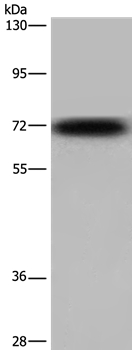
| WB | 咨询技术 | Human,Mouse,Rat |
| IF | 咨询技术 | Human,Mouse,Rat |
| IHC | 咨询技术 | Human,Mouse,Rat |
| ICC | 技术咨询 | Human,Mouse,Rat |
| FCM | 咨询技术 | Human,Mouse,Rat |
| Elisa | 咨询技术 | Human,Mouse,Rat |
| Aliases | KV4.3; SCA19; SCA22; KCND3L; KCND3S; KSHIVB |
| Entrez GeneID | 3752; |
| WB Predicted band size | 73kDa |
| Host/Isotype | Rabbit IgG |
| Antibody Type | Primary antibody |
| Storage | Store at 4°C short term. Aliquot and store at -20°C long term. Avoid freeze/thaw cycles. |
| Species Reactivity | Human,Mouse |
| Immunogen | Fusion protein corresponding to residues near the C terminal of human potassium voltage-gated channel, Shal-related subfamily, member 3 |
| Formulation | Purified antibody in PBS with 0.05% sodium azide. |
+ +
以下是关于KCND3抗体的3篇参考文献及其摘要概括:
---
1. **文献名称**: *"KCND3 mutations in Brugada syndrome: Insights into channel trafficking and function"*
**作者**: Giudicessi JR, et al.
**摘要**: 本研究分析了KCND3基因突变导致Brugada综合征的机制,发现突变通过干扰Kv4.3通道的细胞膜定位及功能,引发心脏复极化异常,从而增加心律失常风险。抗体检测用于确认突变蛋白的异常表达。
---
2. **文献名称**: *"Reduced expression of KCND3 contributes to atrial fibrillation via electrical remodeling"*
**作者**: Ishikawa T, et al.
**摘要**: 通过动物模型和人类组织样本,研究发现房颤患者心房组织中KCND3表达显著降低,导致瞬时外向钾电流(Ito)减弱,促进电重构。KCND3抗体用于Western blot和免疫组化验证蛋白表达变化。
---
3. **文献名称**: *"KCND3 loss in cerebellar Purkinje cells leads to neurodegenerative changes and motor deficits"*
**作者**: Duan Y, et al.
**摘要**: 在小脑浦肯野细胞中特异性敲除KCND3基因的小鼠模型中,观察到动作电位形态异常和神经元退化,提示Kv4.3通道对运动协调至关重要。研究利用KCND3抗体进行组织特异性蛋白定位分析。
---
4. **文献名称**: *"Molecular mechanisms of cardiac potassium channel trafficking"*
**作者**: Hund TJ, Mohler PJ
**摘要**: 综述了Kv4.3等心脏钾离子通道的运输机制及其调控蛋白(如KChIP2),强调KCND3抗体在解析通道复合体组成和疾病相关突变研究中的应用。
---
以上文献覆盖了KCND3在心脏疾病、神经退行性疾病中的功能及抗体实验应用,均为领域内代表性研究。如需具体文献来源,建议通过PubMed或期刊数据库进一步检索。
×